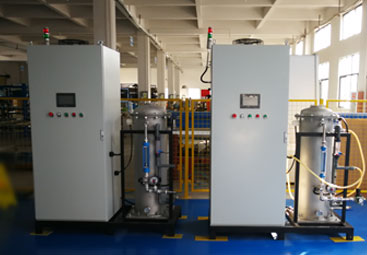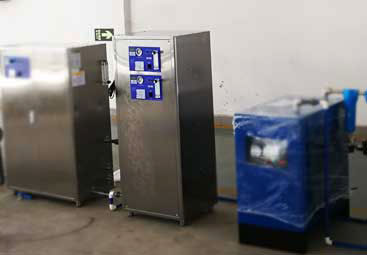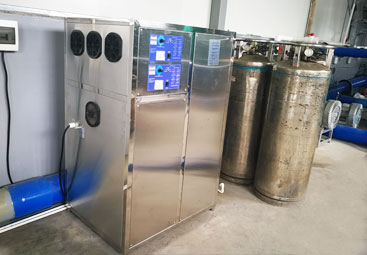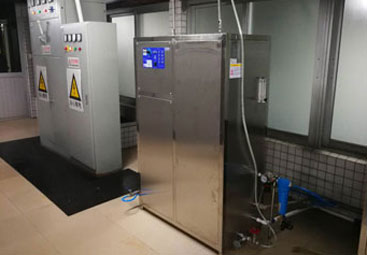You Position::home»Application»ozone Application in wastewater treatment
ozone Application in wastewater treatment
Author:www.dahuan.net Views:date:2019-02-14 15:31
Industrial wastewater treatment - an ozone system capable of handling almost all types of wastewater. The operating conditions for ozone oxidation of wastewater depend on the type of industry and the type of wastewater. These runs can be categorized as follows:
*The entire process (single chemical process, chemical / biological and chemical / biological / physical combination process)
*Application (in-house pre-treatment for water recycling, or water for indirect discharge to public water facilities and water treatment for the end of pipe networks for direct discharge to rivers and bays)
* Removal of compounds (oxidative conversion of toxic or colored substances, reduction of comprehensive parameters (DOC or COD), disinfection or removal of particulate matter)
Ozone oxidation biodegradable process phase combination process is usually used to reduce ozone dosage and operating costs. (ie O3-Bio-O3 system).
First, disinfection
Before the wastewater is discharged into the receiving water body, the wastewater needs to be disinfected to meet certain water quality standards. If it is desired to treat the treated water directly as irrigation water or process water, it should be disinfected, and it should be added to the ozone of drinking water. More quantity. The most commonly used disinfectants are chlorine and chlorine dioxide for disinfection, while chlorine can form well-known halogenated disinfection by-products (especially trihalomethanes, THMS), which are used for ozone due to the generation of potential disinfection by-products. More and more interested.
The concept of the ct value in Chick-Watson's law (the free disinfectant concentration c multiplied by the effective contact time t) is often used in the design of chemical disinfection. A large number of past and recent studies have confirmed that molecular ozone is a very effective and promising disinfectant, which is superior to free chlorine and chlorine dioxide.
Second, the oxidation of inorganic compounds
Ozone oxidation of inorganic compounds in order to destroy toxic substances in wastewater is mainly limited to the removal of cyanide. In the electrolytic processing of the metalworking and electronics industries, cyanide is used frequently, and it can exist in the formation of free CN-, but more often it is combined with iron or copper and exists in the form of a chelate. When the cyanide ion concentration is higher than 5mg/L, the reaction speed of ozone with free cyanide ion is very fast, indicating that the reaction may be controlled by the mass transfer process, and the complex cyanide is very stable to the attack of molecular ozone. Nitrite (NO2-) and sulfide (H2S/2-) can be removed by ozone oxidation. Both types of substances react very quickly with ozone.
Third, the oxidation of organic compounds
Most of the substances that cause problems in industrial wastewater are organic matter. Usually, a mixture of different substances and different concentrations (concentration can be from mg/L to g/L) is to be treated. The main tasks of wastewater ozone treatment are:
* Conversion of toxic compounds
* Partial oxidation of components that are difficult to biodegrade in dissolved organic carbon (DOC) with the aim of improving subsequent biodegradability.
* Remove chromaticity
Similar to drinking water treatment, it is difficult to fully mineralize DOC in an economical way. It is recommended to use a combination of ozone oxidation and other processes. The success of the process is measured by total DOC removal. Ozone oxidation systems have been used to treat wastewater, such as landfill leachate, wastewater from the textile, pharmaceutical and chemical industries. The main pollutants in these waters are refractory organics, which can be classified as follows:
* Humus (brown or yellow) and adsorbable organic halide (AOX) in landfill leachate
*Colored (poly) aromatic cluster compounds in textile wastewater (this type of material is often mixed with a large number of metal ions Cu, Ni, Zn, Cr)
* Toxic or biocidal substances (eg pesticides) produced by the pharmaceutical and chemical industries
* Cosmetics and other industrially produced surfactants
* COD and colored materials in pulp and papermaking waste liquids. In the wastewater ozonation system, the most common operational problem is the production of foam, which forms calcium oxalate, carbonic acid and ferric hydroxide (Fe(OH)3). Block the reactor, piping or valves and damage the pump.
Fourth, sewage oxidation water quality, water volume analysis
According to the sewage discharged from residential communities, the key projects exceeding the standard are COD, BOD, suspended solids, various types of colloids, and various bacteria for sampling and analysis.
1 design standard
After sewage treatment, the concentration and content of COD, BOD, suspended solids SS, and total dissolved solids of various bacteria conform to Chinese
The water quality standard for reclaimed water in the Ministry of Construction of the People's Republic of China is CJ25.1-89.
2 Design basis
(1), Environmental Protection "Ninth Five-Year Plan" and 2010 long-term goal planning.
(2), sewage sampling report.
(3), <Outdoor Drainage Design Specification> (GBJ14-87).
(4) CJ25.1-89, Standard for Living Miscellaneous Water in the Ministry of Construction of the People's Republic of China.
3 Design principles
(1) Seriously implement the relevant laws, standards and regulations. According to the actual situation of the sewage in the community, adopt a practical and feasible treatment plan, which meets the requirements of good treatment effect, low construction investment, low operating cost and simple management and operation.
(2) After the wastewater treatment, it shall comply with the CJ25.1-89 standard for domestic miscellaneous water use by the Ministry of Construction of the People's Republic of China.
4. Technical process flow brief:
(1), closed safety membrane, biological reaction landfill leachate treatment process Key: membrane bioreactor technology + O3
(2), closed and safe biological oxidation process landfill leachate treatment process Key: biological contact oxidation technology combined with high efficiency inclined plate precipitation + O3
(3), SBR landfill leachate treatment process Key: SBR oxidation process + O3
5, water reuse treatment process: contact oxidation - filtration process
-- End --
Next Page :No more Previous Page:Residential Air purification Application
We found other products you might like!
Similar article ranking
- Residential Air purification Application
- ozone Application in wastewater treatment
- Ozone application in aquarium
- Ozone Application in Aquaculture
- ozone Application in Pure water treatment
- Ozone application in swimming pools
Ozone Equipment
- 50g-100g Ozone Generator
- Portable Household Ozone Generator
- 40g-100g ozone & oxygen machine
- SOZ-10G ozone generator
- 40g-200g ozone & oxygen machine
- OW Series Oxygen Generator
- DH-A Dryer
- Negative Pressure Ozone Generator
Ozone Application
- Residential Air purification Application
- ozone Application in wastewater treatment
- Ozone application in aquarium
- Ozone Application in Aquaculture
- ozone Application in Pure water treatment
- Ozone application in swimming pools
Latest news articles
- Ozone generator components and functions
- Ozone generator air source comparison
- Application of ozone generator in sewage treatment
- Application of ozone in cold storage
- How to ensure that ozone concentrations in clean areas are u
- How long after ozone disinfection will the air return to a s
- Application of ozone in washing water industry
- Can ozone generator remove formaldehyde
- How to ozone disinfection of bottled water
- Ozone generator solution for disinfecting pure water and min
- Swimming pool water disinfection ozone application technolog
- The application of ozone in the car wash industry
- Glossary of terms related to ozone
- Swimming pool ozone generator sterilization principle
- space disinfection equipment selecting
- Precautions for selecting a space disinfection ozone generat
- Method for preparing ozone during swimming pool disinfection
- Warmly celebrate the 21st anniversary of BNP
- Ozone generator concentration constant constant system
- Textile and garment fabric ozone decolorization system




